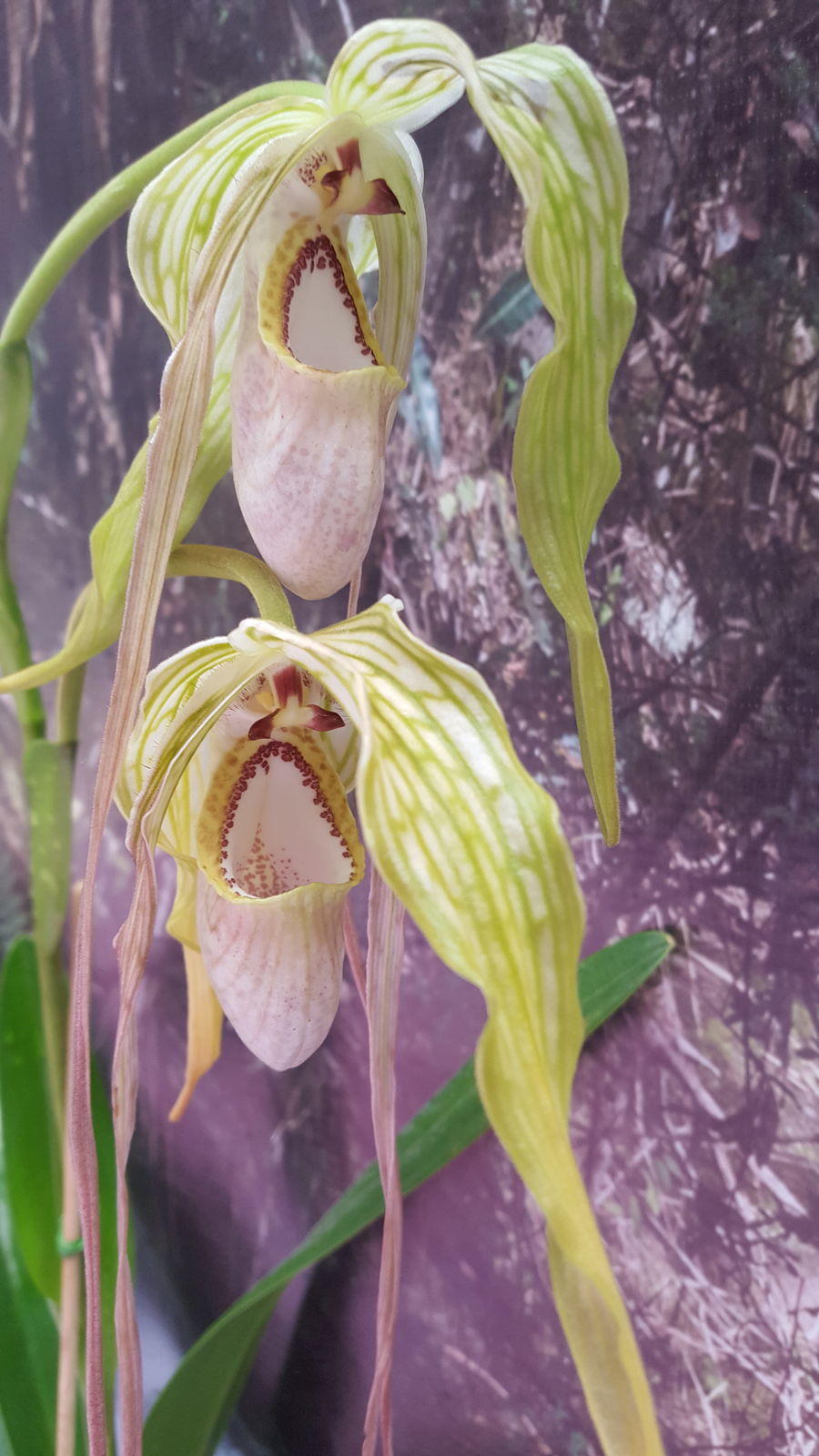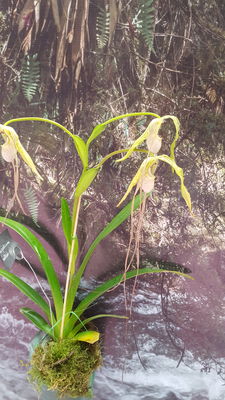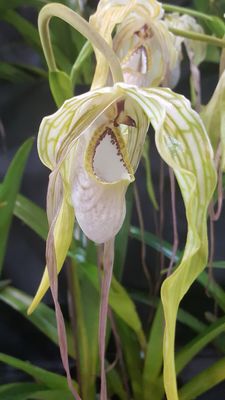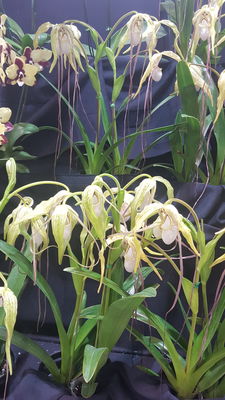-
General Description
-
Small to large terrestrial, lithophytic or epiphytic herbs with elongate, fibrous roots arising from a short to elongate rhizome. Erect shoots leafy, clustered or less frequently well spaced, glabrous, the base enclosed by two to four sheathing sterile bracts, three- to several-leaved above. Leaves several, coriaceous, conduplicate, spreading or suberect, ligulate, elliptic, or oblong, obtuse to acute, often tridenticulate at apex, mid- to dark green on upper surface, lighter green below, glabrous, ciliate or not on the margins. Inflorescence terminal, occasionally branching, few- to many-flowered; rachis terete, hairy, glandular or glabrous; bracts conduplicate, elliptic, lanceolate, ovate or oblong, green, sometimes spotted or flushed or striped with purple, ciliate or not. Flowers deciduous, usually showy, concolorous or not, vernation imbricate; pedicel obscure to short; ovary trilocular, three-ribbed, glabrous or hairy. Dorsal sepal erect to hooded over lip, ovate, lanceolate, obovate or elliptic, obtuse, acute or acuminate, glabrous or pubescent on the outer surface, sometimes pubescent within at base, ciliate or not. Lateral sepals usually fused to form a concave synsepal that is more or less similar to the dorsal sepal, sometimes keeled on outer surface. Petals free, spreading or pendent, flat, reflexed or spiraling, elliptic, ovate, lanceolate, linear-lanceolate, linear or oblanceolate, rounded, obtuse, acute or acuminate at apex, often pubescent in basal half within, usually ciliate. Lip deeply pouched and inflated, slipper-shaped or urn-shaped, with more or less pronounced incurved side lobes, rarely petaloid, hairy within especially on lower surface, glabrous or hairy on outer surface; front margin incurved or not. Column short, stalked, porrect; anthers two, bilocular, borne on short obtuse to acute filaments; pollen powdery or viscid; staminode terminal on column, sessile or shortly stalked, transversely reniform, oblong, ovate, obcordate or linear, flat, convex or longitudinally conduplicate, glabrous to papillose or finely pubescent, ciliate or not; stigma stalked, dependent, tripartite, more or less papillose. Capsule erect to pendent, three-ribbed, cylindrical to almost ellipsoidal. (PC).
-
Habitat
-
Phragmipedium species are found in the tropics from southern Mexico to Bolivia and Brazil. Rarely found near sea level (Phragmipedium longifolium), they may be found as high as Machu Picchu in Peru (Vargas 1965) or close to 2500 m elevation. The southernmost species are found in Bolivia and São Paulo, Brazil, but apparently no species have been able to spread into the more temperate parts of South America. Some of the species such as P. besseae are found within narrow elevation bands (1300-1900 m), but Phragmipedium longifolium may be found from sea level to 1600m elevation. We have noted that plants collected at 1600 m produce more lanky growth in heated greenhouses than do plants from near sea level.
-
Distribution
-
Southern Mexico and Guatemala through Central America to South America, south to Bolivia and Brazil. A small genus of about 15 species.
-
Ecology
-
A few species are epiphytic (some of the P. caudatum group), but most are terrestrial or lithophytic, particularly near waterfalls. The Central American populations of the Phragmipedium caudatum complex are largely epiphytic from Panama to Nicaragua but terrestrial or lithophytic on granite (Fowlie 1972) in South America. Dodson (personal communication) indicated that P. lindenii grows on lava. Phragmipedium exstaminodium is epiphytic in southern Mexico.
Most species grow terrestrially or lithophytically in crevices of volcanic rock, usually in association with river systems. Phragmipedium longifolium usually grows on landslides near rivers where they probably must re-colonize before the canopy closes after a disturbance. Commonly, the substrate on which they are growing is dark and slippery, suggesting that the plants may benefit from a mat of cyanobacteria. Plants are sometimes seen invading road cuttings which apparently simulate landslides by rivers. Some populations in Panama, however, are known only on open rocks often in the centres of swift-running rivers where they receive sufficient light. In such a habitat the plants are dwarfed, sometimes producing an inflorescence less than 20 cm tall. These plants remain dwarfed in cultivation and flower poorly unless given full sunlight. They may be subjected to periodic flash flooding and become lost to raging torrents. Similarly, species such as P. pearcei, P. boissierianum, P. hirtzii, and P. caricinum grow near rivers. Perhaps the most specialized species is P. klotzschianum (Dunsterville 1932; Gorinsky 1972) which grows at the junction of Venezuela, Guyana, and Brazil. This species is found between 1300-1400 m elevation growing on sandstone by streams where plants have a constant supply of water to their roots. Fowlie (1986) reported that P. sargentianum grows in seeps over granite.
A few species grow on limestone or on serpentine. Phragmipedium besseae grows on vertical dripping cliffs often near waterfalls. Its precipitous habitat, generally avoided by plant collectors, probably explains why it remained undiscovered for so long. It seems to prefer growing on serpentine as the rock has a soapy texture and reacts to strong acid (Stig Dalström, personal communication).
Most Phragmipedium species can grow in fairly strong and sometimes direct sunlight, but more frequently the light is dappled by the surrounding vegetation. None of the species prefers deep shade, and the poor flowering of large plants growing in deep shade attests to their preference for stronger light.
Phragmipediums prefer high humidity of the rainforests in which they grow and where rainfall is frequent throughout the year. Some do not mind growing in areas where water is standing for short periods. In contrast, the P. caudatum complex will not tolerate standing water around their roots. (JA).






